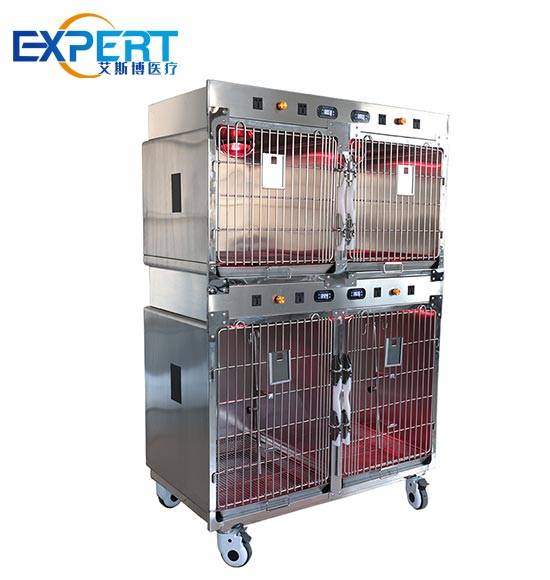Indirizzo
304 Il cardinale nord S.
Dorchester Center, MA 02124
Ore di lavoro
Dal lunedì al venerdì: 7:00 - 19:00
Fine settimana: 10:00 - 17:00
Benvenuti nel mio blog!
Prima di immergerci nei contenuti, mi piacerebbe che ti unissi a me sulle mie piattaforme social, dove condivido altre intuizioni, interagisco con la community e pubblico aggiornamenti. Ecco come puoi metterti in contatto con me:
Facebook:https://www.facebook.com/profile.php?id=100071234835011
LinkedIn:https://www.linkedin.com/company/74943205/admin/dashboard/
YouTube:www.youtube.com/@shandongexpertmedicalequip4695
TikTok:www.tiktok.com/@expertmedical
Ora, iniziamo il nostro viaggio insieme. Spero che tu trovi il contenuto qui perspicace, coinvolgente e prezioso.

In the field of veterinary medicine, the ability to respond quickly and effectively to emergencies can make the difference between life and death for an animal. One critical piece of equipment in emergency veterinary care is the oxygen cage. An emergency veterinary oxygen cage is a specialized enclosure designed to provide a controlled environment where animals in critical condition can receive oxygen therapy. These cages are essential for treating conditions such as respiratory distress, shock, and certain types of poisoning. This blog will guide you through the top 10 emergency veterinary oxygen cages available for animal hospitals, helping you make an informed decision on the best equipment for your practice.
An emergency veterinary oxygen cage is a sealed enclosure that allows for the administration of oxygen to animals in a controlled environment. These cages are often used in veterinary hospitals and clinics to treat animals suffering from conditions that impair their ability to breathe. The controlled environment helps stabilize the animal’s condition by ensuring they receive a steady supply of oxygen, which is crucial in emergency situations.
A high-quality emergency veterinary oxygen cage should have several key features to ensure it meets the needs of both the animal and the veterinary staff:
Having an emergency veterinary oxygen cage in your animal hospital is essential for several reasons:
The Smiths Medical SurgiVet Recovery Oxygen Cage is a popular choice among veterinary professionals due to its reliability and advanced features. It offers precise control over oxygen concentration, temperature, and humidity, ensuring the animal’s comfort and safety.
This cage is ideal for veterinary hospitals that frequently handle critical cases and need a reliable and fully-featured oxygen cage.
The ICU Intensive Care Unit Oxygen Cage is designed for high-performance oxygen delivery and patient monitoring. It provides a stable and controlled environment for animals in need of intensive care.
This cage is perfect for busy veterinary clinics that require a portable and easy-to-use solution for emergency oxygen therapy.






The Expert Pet Oxygen Cage is a durable and versatile option for veterinary practices. It is built with high-quality materials and designed for long-term use, making it a sound investment.
This unit is ideal for veterinary hospitals looking for a long-lasting, high-quality oxygen cage that can withstand frequent use.
Jorgensen Laboratories is known for producing high-quality veterinary equipment, and their oxygen therapy cage is no exception. It combines advanced features with a user-friendly design, making it suitable for a wide range of veterinary applications.
This cage is ideal for veterinary clinics that require a versatile, easy-to-maintain oxygen cage for various emergency situations.
The Snyder Manufacturing Critical Care Oxygen Cage is designed specifically for critical care scenarios, providing comprehensive control over the environment within the cage.
This cage is suitable for specialized veterinary hospitals focusing on critical care and emergency services.
The Vetario T30M is a compact and efficient oxygen cage that offers all the necessary features for emergency veterinary care. Its compact size makes it perfect for clinics with limited space.
This unit is ideal for smaller veterinary clinics that need an efficient and compact solution for oxygen therapy.
The Midmark Matrx Oxygen Cage is a high-performance unit designed to provide maximum control over the animal’s environment, ensuring optimal care during critical situations.
This cage is perfect for larger veterinary hospitals that require a robust and highly controllable oxygen therapy solution.
The Snyder ICU Intensive Care Unit Cage is built for intensive care, offering comprehensive environmental control and monitoring features to support critical care patients.
This cage is ideal for veterinary practices that handle a high volume of critical care cases and need a reliable, easy-to-move oxygen cage.
This combination unit offers both an oxygen concentrator and an oxygen cage, providing a complete solution for veterinary oxygen therapy needs.
This combo is ideal for veterinary clinics looking for an all-in-one solution that combines oxygen generation and therapy in a single, easy-to-use package.
The PetSavior Veterinary Oxygen Therapy Cage is a budget-friendly option that does not compromise on quality. It offers essential features needed for effective oxygen therapy in a veterinary setting.
This cage is ideal for smaller practices or those looking for a cost-effective solution that still offers reliable performance for emergency veterinary oxygen therapy.

| Marca/Modello | Oxygen Delivery | Controllo della temperatura | Ventilazione | Portabilità |
|---|---|---|---|---|
| Smiths Medical SurgiVet Recovery Oxygen Cage | Regolabile | Integrated heating | SÌ | medio |
| ICU Intensive Care Unit Oxygen Cage | High-efficiency | Dual heating/cooling | Dual system | Alto |
| Expert Pet Oxygen Cage | Efficient adjustable system | Constant temperature controller | SÌ | Basso |
| Jorgensen Laboratories Oxygen Therapy Cage | Low oxygen consumption | Heating and cooling | SÌ | medio |
| Snyder Manufacturing Critical Care Cage | Precise control | Regolabile | Advanced system | Basso |
| Vetario T30M Intensive Care Unit | Effective and efficient | Excellent stability | Basic system | Alto |
| Midmark Matrx Oxygen Cage | High-precision system | Heating and cooling | CO2 monitoring | Basso |
| Snyder ICU Intensive Care Unit Cage | Full environmental control | Fully adjustable | SÌ | Alto |
| MPM Medical Oxygen Concentrator/Cage Combo | Integrated system | Di base | SÌ | medio |
| PetSavior Veterinary Oxygen Therapy Cage | Efficient and simple controls | Di base | SÌ | Alto |
Scegliere il giusto emergency veterinary oxygen cage for your animal hospital is crucial for providing high-quality care to your patients. The options listed in this guide offer a range of features and price points, allowing you to select the best equipment that fits your specific needs and budget. Whether you need a fully-featured oxygen cage with advanced monitoring systems or a budget-friendly option that still delivers reliable performance, the right choice can make a significant difference in your ability to respond to emergencies effectively.
What is the primary function of an emergency veterinary oxygen cage?
The primary function of an emergency veterinary oxygen cage is to provide a controlled environment where animals can receive oxygen therapy. These cages are essential for treating animals in respiratory distress, shock, or other critical conditions that impair their ability to breathe.
How do I choose the right size of an emergency veterinary oxygen cage for my practice?
Choosing the right size depends on the types and sizes of animals you typically treat. Ensure the cage is large enough to comfortably accommodate the largest animals you expect to treat while still being efficient for smaller patients.
What safety features should I look for in an emergency veterinary oxygen cage?
Look for safety features such as alarms for oxygen levels, temperature fluctuations, and CO2 buildup. These features ensure that the animal remains safe and that the environment inside the cage remains stable.
Can I use an emergency veterinary oxygen cage for other types of therapy?
Yes, many emergency veterinary oxygen cages can be used for other types of therapy, such as humidity therapy or temperature regulation, making them versatile tools in veterinary care.
How often should I perform maintenance on an emergency veterinary oxygen cage?
Regular maintenance is essential to ensure the cage functions correctly. This includes checking and calibrating the oxygen delivery system, cleaning the cage, and inspecting all safety features. Follow the manufacturer’s guidelines for specific maintenance intervals.
